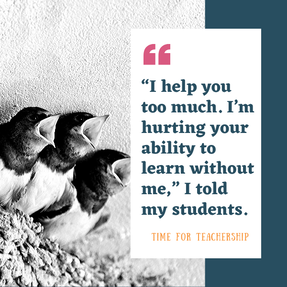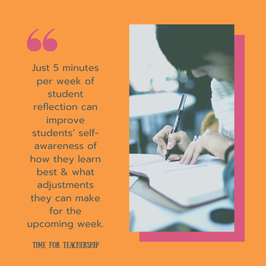|
This blog post is the second of two related posts on student independence. I encourage you to go check out the first post before reading this one! It covers what student independence is (a process of self-regulation phases), why it’s important (it leads to improved student motivation and academic performance and is a requirement for the job market of the near future). When students can work independently, you are able to meet with students 1:1 or in small groups. They can speak to their learning processes and their progress on course-specific standards. Sounds great, right? In the previous post, I shared 4 tips on how to prepare for fostering student independence. This discussed planning differentiated lesson activities, being clear about the course/unit end goals, and consistently building relationships with students. While the preparation piece is critically important, this post focuses on strategies for teachers to implement during and after learning activities to foster students’ metacognitive thinking and help them take ownership of their learning. During a learning activity, teachers can: Use “3 before me”. This is one of the most important strategies I can recommend. As a teacher, I did not use it enough. I would rush over to help whenever students yelled, “Miss!” Finally, I made my teacher goal explicit to students. “I help you too much. I’m hurting your ability to learn without me,” I said. I made a large poster with a list of not 3, but 6 possible sources of information to go to when students had a question (before asking me). I put it up on the wall, and for the next week, we chorally recited the steps at the start of each class. To see how other teachers represent this strategy, google image search “3 before me”. There are tons of poster ideas. Follow a question with a question. When a student does make it to you with a question, ask them a question to help them generate an answer on their own. If it’s a feedback question, ask, “What do you think?” before you provide your own feedback. I also like, “What do you want me to focus on?” when students ask me to review writing drafts. It forces them to reflect on what they struggle with most, and it saves me time from pointing out all of the tiny errors that won’t be as high-leverage as one big topic like organization. When they are stuck, try asking, “What will help you most?” to prompt students to think metacognitively about how they learn best. This is a helpful first step to eventually getting them to seek out effective resources on their own. Model independent learning. Think alouds are great for this. Problem solve a practice problem in front of the class, and model what you are thinking and make explicit the steps you are taking to learn something new or complete a task. Provide focused & actionable feedback on students’ work. As I’ve talked about before, formative feedback has a big impact on student learning and saves you time grading student work after class. You can provide feedback on the specific task, but you can also provide feedback for students’ learning processes. Try to go beyond a generic, “You’re working hard,” which is certainly nice to hear, but a comment like, “I love that you chose to rewind the video and replay part of it so that you could answer the comprehension question,” can help students pinpoint what learning strategies as they are using and model for other students possible strategies to use. After a learning activity, teachers can: Ask students to reflect. Taking just 5 minutes per week for students to jot written journal reflections or record video journals can improve students’ self-awareness of how they learn best and what adjustments they can make for the upcoming week. Ask students to track their progress. In addition to reflecting on their learning process, you can also ask students to self-assess their progress towards the course standards they have been working towards. Students can also track their own formative and/or summative assessment data to monitor their progress. This can be done digitally (e.g., Google Sheets) or with crayons and paper. These don’t have to be publicly displayed, but could live in students’ data binders to keep it private. These strategies do not all need to be implemented right away. You can try out one at a time. The key is to make student independence one of the goals of your class. By doing this, you can address a lot of other struggles (e.g., off-task behavior, lack of motivation, students’ low academic performance). I’d love to hear what other strategies you have for fostering independence! Share in the comments, in our facebook group, or tag me on your preferred social media platform.
0 Comments
Leave a Reply. |
Details
For transcripts of episodes (and the option to search for terms in transcripts), click here!
Time for Teachership is now a proud member of the...AuthorLindsay Lyons (she/her) is an educational justice coach who works with teachers and school leaders to inspire educational innovation for racial and gender justice, design curricula grounded in student voice, and build capacity for shared leadership. Lindsay taught in NYC public schools, holds a PhD in Leadership and Change, and is the founder of the educational blog and podcast, Time for Teachership. Archives
May 2024
Categories |





 RSS Feed
RSS Feed